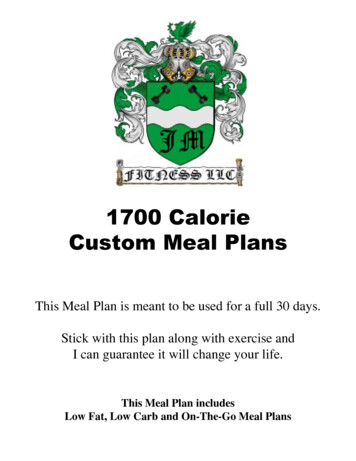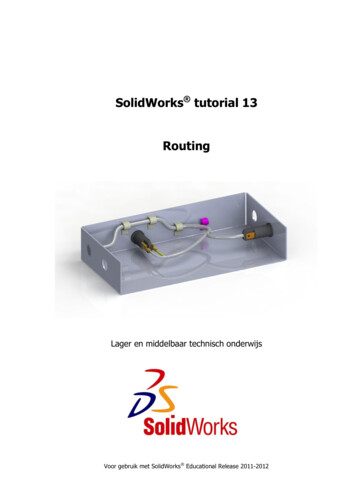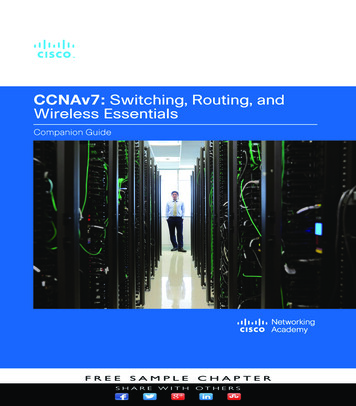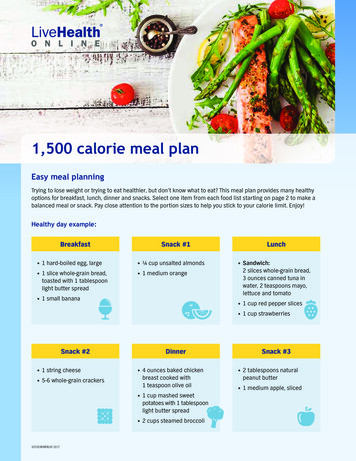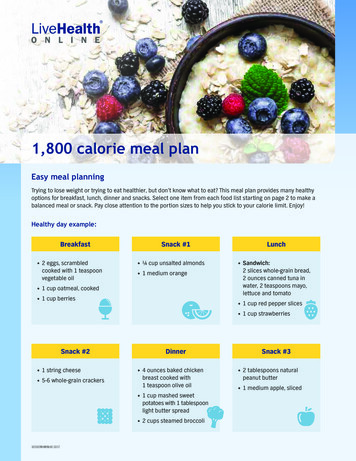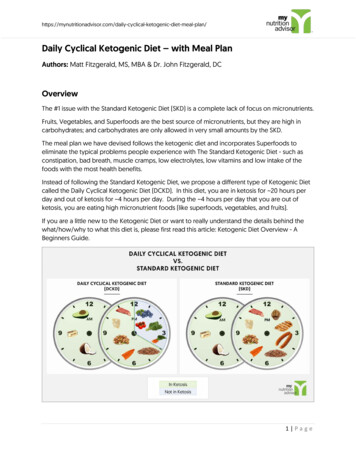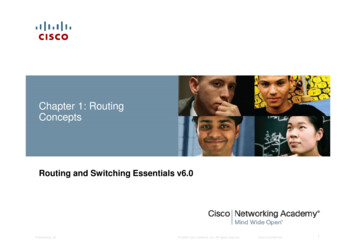
Transcription
The Meal Delivery Routing ProblemDamian Reyes1 , Alan Erera1 , Martin Savelsbergh1 ,Sagar Sahasrabudhe2 , and Ryan O’Neil21H. Milton Stewart School of Industrial Engineering, Georgia Institute of Technology,Atlanta, GA 30332-02052Decision Engineering Department, Grubhub, Chicago, IL 60602March 1, 2018AbstractWe introduce the Meal Delivery Routing Problem (MDRP) to formalize and study an importantemerging class of dynamic delivery operations. We develop optimization-based algorithms tailoredto solve the courier assignment (dynamic vehicle routing) and capacity management (offline shiftscheduling) problems encountered in meal delivery operations. Extensive computational experiments using instances with realistic size, geography, urgency and dynamism demonstrate that ouralgorithmic ideas provide solid foundations for real-world implementations.1IntroductionOnline restaurant aggregators – on-demand meal-ordering platforms where diners order their favoritecravings from an array of restaurants – are growing at a fast pace [5], and with them, the volume ofmeal delivery operations is rising quickly worldwide [10], increasing the potential for new economies ofscope, scale, and density. According to Morgan Stanley, “online food delivery could grow by 16% annualcompound rate in [the] next 5 years”[17]. Aiming to capitalize on the market opportunity, emergingproviders are investing heavily [8] in the deployment of meal delivery networks that promise restaurantsand diners a reliable, fast and cost-effective delivery process.While in the short-term the transition from restaurant-owned delivery services (which for manyrestaurants means no deliveries at all) to integrated meal delivery networks can focus on reliability andspeed, the long-term sustainability of these networks is contingent on turning the efficiency potentialinto actual profits. For this purpose, appropriate optimization technologies must be developed to solveincreasingly large dynamic pickup and delivery problems in near-real time, and prescribe high-qualitydecisions able to control costs while satisfying very high service standards.The successful deployment and operation of meal delivery networks is difficult not only due to thescale of these systems, but also due to the dynamism and urgency of arriving orders [26]. Withoutexaggeration, meal delivery is the ultimate challenge in last mile logistics: a typical order is expected tobe delivered within an hour (much less if possible), and within minutes of the food becoming ready, thusreducing consolidation opportunities and imposing the need for more vehicles operating simultaneouslyand executing shorter routes. Furthermore, meal delivery networks must be able to respond to wide,and often abrupt, swings in demand both in spatial and time dimensions.In an attempt to achieve the desired responsiveness without the costs linked to employing a sufficiently large permanent fleet of vehicles (and full-time drivers), meal delivery providers have adopted1
“digital marketplace” business models – where the supply of couriers, i.e., independent contractorsmaking deliveries [21], is managed indirectly through economic incentives. This strategy, first exploredin the context of taxi and ride-hailing services, externalizes fixed costs (to couriers) and enhances theability of the system to plan and control capacity levels over time and geography in sync with demandfluctuations.However, it is worth emphasizing how full reliance on independent-contractors establishes a fundamentally different operating environment than that of traditional vehicle routing applications. Inexchange for internalizing some of the risks and costs associated with demand uncertainty, couriersare entitled to a significant degree of autonomy, thereby adding yet another layer of complexity in thedesign of appropriate optimization technology: company drivers will implement instructions from central planning, whereas independent contractors might do so, thus introducing uncertainty in scheduling(couriers have some freedom to choose the hours they work), dispatching (couriers can reject an offeredassignment), and routing (couriers can disregard the suggested sequence of deliveries).In synthesis, meal delivery networks have ushered in dynamic pickup and delivery problems of unprecedented scale, and meal delivery providers are spearheading the adoption of flexible business models,like crowd-sourced delivery [23], in the last-mile goods-transportation sector. In this study, we are concerned with laying out solid foundations for the design of optimization technologies that can scale up tothe challenge. We have adopted a dynamic deterministic framework, even if this means that novel andinteresting questions (in particular, those related to courier autonomy) are not (yet) explored.The main contributions of this paper are: i) a definition of the Meal Delivery Routing Problem(MDRP) to model the essential structure of this emerging class of dynamic delivery systems; ii) asolution algorithm based on a rolling-horizon repeated matching approach, designed to solve large-scaleinstances of the MDRP; iii) an off-line decision support tool to determine a high-quality schedule ofcourier shifts (which has been used in the instance generation process) iv) the release to the publicdomain of a set of instances built from real-life historic data to facilitate benchmarking of alternativesolution methodologies; v) an extensive computational study demonstrating, among others, that (a) ourapproach achieves high-quality solutions with respect to multiple service objectives, over a wide spectrumof instance characteristics, despite its simplicity and myopism; (b) capacity scheduling decisions have acritical impact on reliability and performance; (c) meal preparation time uncertainty has a minor impacton reliability and performance.We close this section with a brief survey of related literature, contextualizing some of the themesof later sections. In Section 2, we define the Meal Delivery Routing Problem, and then describe oursolution algorithm (together with some possible variations) in Section 3. Next, in Section 4 we presentand discuss the results of a computational study. Finally, in Section 5 we provide some concludingremarks.1.1Related literatureThe MDRP belongs to the large family of dynamic vehicle routing problems (dVRP), more specifically,to the class of dynamic pickup and delivery problems (dPDP). A vast number of researchers have studiedthese problems from different angles for decades, and excellent surveys have been produced by Pillacet al. [18] and Psaraftis et al. [20], in the case of dVRP, and Berbeglia et al. [6], in the case of dPDP.In the next paragraphs we will limit ourselves to mention some recent studies that share some featureswith our work in terms of modeling or solution methodology.Recent research in dPDP has focused mainly on the movement of people, e.g., dial-a-ride and ridesharing applications [1, 9], yet, despite the contextual difference, these problems share some importantsimilarities with the MDRP: the difficulties posed by the increasingly large size of fully-dynamic instances, and the high urgency and low flexibility of the tasks to be scheduled. A frequently proposedstrategy to deal with this challenge is the use of a myopic rolling horizon repeated matching approach, ascalable framework that has been shown to produce high quality solutions (e.g., [24, 28]), making virtue2
out of necessity thanks to the low visibility of future events and the tight time constraints present intaxi and ride-sharing environments.But perhaps the most natural label under which to catalogue the MDRP is that of dynamic deliveryproblems, a type of dPDP that has just recently begun to be studied on its own right, as same-daydelivery services become more and more ubiquitous, in both simplified analytic systems (Archetti et al.[2], Klapp et al. [11], Reyes et al. [22]) and more realistic settings (Azi et al. [4], Voccia et al. [27], Klapp[12], Archetti et al. [3], Dayarian and Savelsbergh [7]). In dynamic delivery problems, vehicles makemultiple trips during the operating period to deliver goods locally from a depot (or a small numberof depots, i.e., restaurants, in the case of the MDRP) to customer locations. Due to the structureof the network (one or few depots), and also due to tight time constraints being modeled, dynamicdelivery solutions have a special structure: once a vehicle is dispatched, modifying the route is highlyundesirable or impractical. This structure is usually enforced directly in the model formulation, byrequiring vehicles to be empty before starting additional pickup operations, which, while restrictive, isnot at all unreasonable when dealing with deliveries of perishable goods, like meals. Ongoing assessmentsby Ulmer et al. [25] on the impact of relaxing this condition in the context of same day delivery suggestthat allowing more flexible routes (preemptive returns in the single-depot case) may increase the numberof customers served during the operating period, but the change on the average delivery times has notbeen thoroughly explored (and a trade-off, i.e., an increase in delivery times, is plausible). Our proposedMDRP model definition does not impose that restriction, as in a multi-depot problem it is conceivablethat routes may benefit from a vehicle making pickups while still executing deliveries from a differentdepot. However, the solution algorithm presented in this paper always uses routes that finish all pendingdeliveries before a new pickup.Having contextualized the problem, let us introduce a few more works which have informed ourmethods. The use of assignment models in rolling horizon strategies has a long history in the realm ofdynamic long-haul fleet management. Here we highlight the pivotal work by Yang et al. [29], where theauthors introduce a dynamic model that captures the essential characteristic of a real-time full truckload dispatching system, and compare a series of rolling horizon policies to assign (and schedule) jobsto trucks, under different operating conditions. The value of advanced information is measured by comparing the performance of myopic assignment policies and a policy that uses some stochastic knowledgeabout the expected location of future pickup and delivery points, and uses these expectations to accountfor the cost of moving trucks to serve future uncertain requests in an otherwise myopic algorithm. Beyond the obvious difference in time scales, the full truckload assumption is a significant departure fromthe meal delivery operating environment. However, we opt for defining route delivery segments (i.e.,consolidation decisions) before solving the assignment problem, which effectively reinstates a similarstructure. While we do not use stochastic methods, we do explore the use of uncertain informationabout the future through the assignment of “follow-on” pick-up and delivery chains, where the laterroute segment will likely still change as more orders arrive, but already contains enough information toanticipate needed vehicle movements.An issue of central importance in the design of dynamic algorithms is how to most effectively balance between the fulfillment of current tasks and the preservation of flexibility to complete future andunknown tasks. On this question, we highlight the work of Mitrovic-Minic et al. [16], who propose a“double horizon” algorithm that evaluates the cost of actions (pickup or drop-off insertions, in this case)using different cost functions if the actions occur in the short-term (within a given horizon) or in thelong-term (anything beyond the horizon), an approach motivated by applications where time windowsare wide and deliveries may occur much later than their corresponding pick-up operation (which is notthe case for on-demand meal delivery). The double horizon heuristic is shown to outperform traditional(single) rolling-horizon algorithms, on instances with time windows ranging between 1 hour and 8 hoursfrom the release time, but with diminishing returns as the size of instances grows. Our solution algorithm incorporates a bi-objective mechanism with the same spirit, but operating in a different way (after3
all, the time constraints in meal delivery are very tight,e.g., 40 minute target since announcement untildrop-off, unlike the problems for which “double-horizon” was conceived): we use information from aninterval possibly different to the “assignment horizon” (i.e., the window of orders to include in routes)to determine how intensely should consolidation opportunities be prioritized. At or before busy periods,like lunch and dinner time, when many orders arrive in a short time-span, the algorithm attempts tocreate more efficient routes, even at the expense of individual order service quality, while in relativelycalm periods, the emphasis switches to delivering orders fast.Another important question in dynamic routing is when to postpone and went to commit to theexecution of decisions in order to mitigate uncertainty. On this topic, the work by Mitrovic-Minic andLaporte [15] comes to the fore. In [15], the distribution of waiting time for any given route is determinedthrough one of 4 “waiting strategies”: Drive First (DF: depart as early as possible), Wait First (WF:depart as late as possible), Dynamic Wait (DF within service zones, WF between service zones), andAdvanced Dynamic Wait (DF within service zones, and slightly less “lazy” than WF between zones),where “service zones” are essentially clusters of consecutive stops in a route determined dynamically. Inopposition to DF, WF tends to lead to more efficient routes, but at the risk of running out of vehicles tocomplete all deliveries by their deadline; as expected, the more complex strategy dominates the rest. Inthe context of meal delivery, service constraints are so restrictive that complex waiting strategies maynot have a critical impact: it makes little sense for a vehicle to wait idle after delivering an order if thereis more work to do, so the main question becomes how much to postpone departures from a restaurant.Our strategy in this regard is described in detail in Section 3.3, and it can be interpreted as a restrictedform of WF at restaurants.Finally, the concepts of dynamism and urgency are fundamental for the study of dynamic deliverysystems, where a large majority, if not the totality, of requests are revealed during the operating period(dynamic requests), and must be completed within a short time window (urgent requests). Naturally, theprecise definition of these concepts has evolved throughout the years. Two decades ago, Lund et al. [14],proposed to measure the degree of dynamism as the proportion of dynamic requests, a rough measureprimarily designed for situations where at least part of the requests are “advance requests”. To makemeaningful comparisons between scenarios with any proportion of dynamic requests, Larsen et al. [13]later refined the definition and proposed the effective degree of dynamism, which attempted to captureboth urgency and evolution of information in a single measure. This definition is the most popular onein recent literature. However, van Lon et al. [26] have recently argued that this popular measure hassignificant flaws, and that dynamism and urgency should be measured separately to correct this. Afterdefining two independent measures, they empirically observe that dynamism, urgency and “cost” arerelated in a non-linear way: low dynamism and high urgency lead to higher costs, but high dynamismand high urgency do not; higher urgency leads to higher costs; and that cost is largely insensitive tochanges in dynamism, all else equal (except for high urgency scenarios, as previously noted). Thisis consistent with the observations of Lund et al. [14], who noted that “even with a large number ofdynamic requests, it is possible to produce good solutions, provided that the dispatcher receives therequests way ahead of the actual service time.” In this paper, we adopt the definitions of [26].2The meal delivery routing problemIn this section, we introduce a stylized model of meal delivery operations, with the goal of formalizingwhat we consider to be their main structural features: multiple pick-up points (restaurants), dynamicorder arrivals, delivery capacity distributed throughout the day in the form of courier shifts, the possibility to pick up multiple orders simultaneously, among others. Being a first attempt to study suchsystems, we have assumed a deterministic dynamic framework. Two important real-life features thatare not captures are the ability of couriers to turn down delivery assignment offers, and the ability ofcouriers to relocate freely when idling. Having said this, let us introduce the model.4
Let R be a set of restaurants, and let each restaurant r R have an associated location r . Let Obe a set of orders, and let each order o O have an associated restaurant ro R, a placement timeao , a ready time (i.e. a release date at the restaurant) eo , and an order drop-off location o . Let Cbe a set of couriers, where each courier c C has an on-time ec (when the courier goes on duty), anon-location c (where the courier will be at time ec ), and an off-time lc ec (when the courier goesoff duty). Assume that all information about R and C is known a priori, but information about anyparticular order o O is revealed only at its placement time ao . The meal delivery routing problemconsists of determining feasible routes for couriers to complete the pick-up and delivery of orders, withthe objective to optimize a single or multiple performance measures. The structural assumptions thatdetermine feasibility, as well as relevant performance criteria are defined as follows.2.1Structural assumptionsOrders from the same restaurant may be combined into “bundles” with multiple drop-off locations,where the ready time of a bundle is the latest ready time of the constituent orders. There is no limit tothe number of orders that may be combined into a bundle.The travel time between any pair of locations is assumed to be invariant over time. The service timeassociated with the pickup of an order at a restaurant, sr , represents the time a courier needs to parkhis vehicle, walk to the restaurant, pick up one or more orders, and walk back to his vehicle. The valueof sr is invariant over time and independent of the number of orders being picked up. Similarly, so ,represents the service time associated with delivering an order at a customer location, i.e., the time acourier needs to park his vehicle, walk to the customer, drop off an order, and walk back to his vehicle.The pickup time of an order (or bundle) at a restaurant is not smaller than the maximum of a) theorder ready time and b) the courier arrival time to the restaurant plus half of the service time at arestaurant. The departure time from a restaurant is the pickup time plus half of the service time. Thedrop-off time of an order is the arrival time of the courier at the customer location plus half of theservice time at a customer location. The departure time after delivering an order is the drop-off timeplus half of the service time.Couriers cannot pick up any orders after their off-time, but are allowed to drop off orders after theiroff-time. More importantly, in this deterministic model, it is assumed that couriers do not execute anyautonomous decisions while on duty. In particular, they always accept any instruction handed to them,and they always wait for (new) instructions at their on-location and at the last location of their activeassignment. Furthermore, couriers cannot receive instructions while executing an assignment and, thus,cannot be diverted while en-route to a restaurant.Payments to couriers follow a guaranteed minimum compensation scheme: a courier earns p1 perdelivered order, or is compensated at the rate of p2 per hour, whichever is higher. Thus a courier collectsmax{p1 n, p2 (lc ec )}, where n is the total number of orders served by the courier.We consider the following variations in the operating environment: Prepositioning. Without prepositioning, the only instruction that can be sent to a courier is to pickup and deliver an order (possibly a bundled-order). With prepositioning, either the instruction tomove to a restaurant (a prepositioning move) or the instruction to pick up and deliver an ordercan be sent to a courier. Assignment updates. Without assignment updates, once the instruction to pick up and deliveran order (possibly a bundled-order) has been communicated to a courier, this assignment has tobe completed before a courier can receive a new instruction. With assignment updates, when acourier arrives at a restaurant to pick up an order (possibly a bundled-order), an instruction canbe sent to the courier updating the order to be picked up. For example, the initial instructionmay have indicated that order o1 had to be picked up and delivered, and the update instructionmay indicate that order o1 and order o2 have to be picked up and delivered (a bundled-order).5
Note that the only assignment update allowed is an update to the set of orders picked up at arestaurant.2.2Performance metricsGiven that meal delivery providers must bring together diners, restaurants and couriers, each with theirown concerns, a number of performance measures are of interest. Some, like click-to-door, which is thedifference between the drop-off time of an order and the placement time of an order, involve a targetvalue, τ , and a maximum allowed value, τmax . The primary performance measures for the meal deliveryrouting problem are:1. Number of orders delivered.2. Total courier compensation.3. Cost per order: total courier compensation divided by number of orders delivered.4. Fraction of couriers receiving guaranteed minimum compensation.5. Click-to-door time: the difference between the drop-off time and the placement time of an order.6. Click-to-door time overage: the difference between the drop-off time of an order and the placementtime of an order plus the target click-to-door time.7. Ready-to-door time: the difference between the drop-off time of an order and the ready time ofan order.8. Ready-to-pickup time: the difference between the pickup time of an order and its ready time.9. Courier utilization: the fraction of the courier duty time that is devoted to driving, pickup service,and drop-off service (as opposed to time spent waiting).10. Courier delivery earnings: courier earnings when considering only the number of orders served.11. Courier compensation: the maximum of the guaranteed minimum compensation (based on thelength of the duty period) and the delivery earnings.12. Orders delivered per hour: for each courier, the number of orders delivered divided by the lengthof the shift.13. Bundles picked up per hour: for each courier, the number of order bundles assigned divided bythe length of the shift.14. Orders per bundle: for each assignment, the number of orders to be picked up.Relevant summary statistics for measures 5-13 are: average, standard deviation, minimum, 10-th percentile, median, 90-th percentile, and maximum.3A rolling horizon algorithm for the MDRPIn light of the highly dynamic and urgent nature of meal delivery operations, making a detailed deliveryplan for orders that will not be ready in the near future is unlikely to be of much advantage. For thisreason, we propose to solve the MDRP using a rolling horizon matching-based algorithm that everyf minutes solves a matching problem to prescribe only the next pick-up and delivery assignment foreach courier. Individual orders may be bundled to be picked-up together and then delivered by a singlecourier following a specified route. After defining tentative courier - order assignments, a commitmentstrategy dictates which of these decisions are postponed and which are communicated to couriers.Furthermore, since a bundle cannot be picked up before all orders are ready, the assignment of abundle with a ready time far into the future is likely to be postponed (the most likely outcome of the commitment strategy), our algorithm focuses on finding assignments only for the subset of known upcomingorders whose ready time falls within t u , the assignment horizon, Ut {o Ot : eo t u }. So,at optimization time, t, the algorithm determines the best assignment of orders in Ut to the couriers onduty.6
3.1Bundles and routesWhile ideally every order should be picked up at its ready time and delivered by its target drop-off time(derived from target click-to-door time), this goal must be reconciled with the reality of a limited setof couriers. Especially during busy periods of the day, it may not always be possible to pick up ordersas they leave the kitchen and deliver them individually. Therefore, to better utilize capacity, couriersmay pick-up and deliver multiple orders, increasing the utilization of couriers at the expense of somefreshness loss. At optimization time t, the algorithm determines how many orders should be in a bundle(defining a target bundle size), and then defines a satisfactory grouping and sequencing of the individualorders that will be assigned to couriers. Since we always define bundles with a unique route associatedto them, from now on we may refer to bundles as routes indiscriminately.System intensity and a target bundle size. A target bundle size may simply be defined as a fixednumber throughout the whole operating period, or throughout predefined intervals, such as “lunch” and“dinner” times. However, to induce robustness and responsiveness in our solution method, we definesuch target in a dynamic fashion, in direct relation to a fraction of the form (#orders ready)/(# couriers available),a rough measure of the amount of work that must be completed with the available resources during agiven period of time. By doing this, we intend to encourage single-order bundles when there are fewerorders than couriers, and favor larger bundles when there are more orders than couriers and the systemis under pressure. A parametric definition of the target bundle size at optimization time t is: {o Ot : eo t 1 } , 1 0, 2 0,Zt {d Dt : ed t 2 } where eo is the ready time of order o and ed is the time when courier d becomes available for a newassignment. Note that it is possible that there are no couriers available before t 2 , in which caseZt is set to some default value. Specific values for u , 1 and 2 are set through a tuning procedure,but, heuristically, for the algorithm to have an anticipatory character, f u 6 1 and f u 6 2should holdCreation of bundles andS delivery routes. Once a system-wide target bundle size Zt has beendetermined, the set S Sr of bundles to be assigned is built by processing the upcoming orders atr Reach restaurant r, Ut,r , following the steps described in Procedure 1.Note that once a bundle reaches its target size, an additional order is inserted only if this increasesroute efficiency, i.e., the time per order delivered in that bundle decreases. Also note that the parameterβ, which controls the importance of freshness in the construction of bundles, is given beforehand (i.e.,it should be tuned off-line).3.2Assignment logicAt the core of our algorithm, the solution of a bipartite matching problem assigns order bundles tocouriers, dictating the next delivery route to be executed by each courier. Such a simple model is ableto capture and balance the trade-off between short-term efficiency and service quality, while ensuringthat, in practical implementations, optimization is not a significant bottleneck in the overall solutionprocess. But, of course, simplicity comes at the cost of expressiveness: the only levers to guide decisionsin the matching are the weights and feasibility conditions of order-courier pairs, and only so many aspectsof the problem can be captured by these. In an attempt to retain some more control in the assignmentprocess, specifically around the issue of how to avoid service delays for bundles that are already late,we introduce a priority scheme: assignments are built by first partitioning the set of relevant bundlesin priority groups based on their “urgency”, and then finding optimal assignments sequentially for eachgroup.7
Procedure 1: Bundle generation using parallel-insertionInput: Ut,r , set of upcoming orders at restaurant r,Zt , target bundle size,and ktr , number of couriers that available at r (see Section 3.3).Output: Sr , set of bundles from restaurant r to be assigned to couriers./* Initial construction*/Sort the orders in Ut,r by non-decreasing ready time;Compute the target number of bundles to create, mr max (ktr , d Ut,r /Zt e);Initialize empty routes (bundles) s1 , s2 , . . . , smr in Sr ;for o Ut,r doFind the route s Sr and the insertion position is for order o into route s which results intheP minimum increase in routeP cost, where the route cost of s isT ravelT ime(p, q) βServiceDelay(p);(p,q) sp sif s Zt and insertion decreases route efficiency thenDisregard s for order o and find the next best route and insertion position (repeat ifnecessary)endInsert o in route s at position is ;end/* Improvement by ‘‘remove-reinsert’’ local-search*/for o Ut,r doRemove o from its current route;Given the existing routes in Sr , find route s and position is to re-insert o at minimum cost;Re-insert o into route s at position is ;end8
Priority scheme. Orders are classified according to their unavoidable delays in drop-off and pick-up: Group I: orders whose target drop-off time is impossible to achieve. Group II: orders not in Group I which can no longer be picked up at their ready time. Group III: orders not in Group I or II.A bundle is assigned the highest priority of any of its constituent individual orders.By creating assignments sequentially for these p
In synthesis, meal delivery networks have ushered in dynamic pickup and delivery problems of un-precedented scale, and meal delivery providers are spearheading the adoption of exible business models, like crowd-sourced delivery [23], in the last-mile goods-transport


